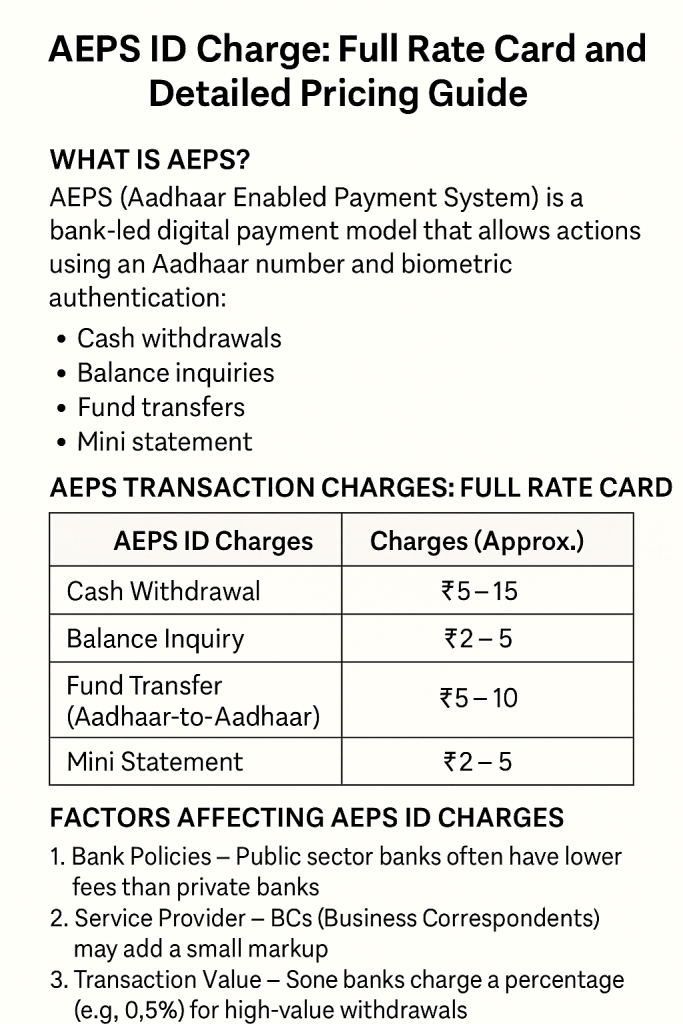How much is the charge for AEPS ID? If you’re using Aadhaar-enabled payment services (AEPS) for banking transactions, understanding the fees involved is crucial. The AEPS ID charge varies depending on the transaction type, bank, and service provider. In this detailed guide, we’ll break down the full AEPS rate card, explain factors affecting pricing, and help you find the most cost-effective options.
What is AEPS?
AEPS (Aadhaar Enabled Payment System) is a bank-led digital payment model that allows transactions using only an Aadhaar number and biometric authentication. It enables:
-
Cash withdrawals
-
Balance inquiries
-
Fund transfers
-
Mini statements
Since AEPS eliminates the need for cards or PINs, it’s widely used in rural and semi-urban areas where traditional banking infrastructure is limited.
Understanding AEPS ID Charges
The AEPS ID charge refers to the fees applied per transaction. These charges are set by:
-
Banks (public, private, and regional rural banks)
-
Payment service providers (like PayNearby, Fino, and Eko)
-
Government regulations (NPCI guidelines)
AEPS Transaction Charges: Full Rate Card
Below is a general breakdown of AEPS ID charges for different transactions:
| Transaction Type | Charges (Approx.) |
|---|---|
| Cash Withdrawal | ₹5 – ₹15 |
| Balance Inquiry | ₹2 – ₹5 |
| Fund Transfer (Aadhaar-to-Aadhaar) | ₹5 – ₹10 |
| Mini Statement | ₹2 – ₹5 |
Note: Charges may vary slightly between banks and BCs (Business Correspondents).
Factors Affecting AEPS ID Charges
-
Bank Policies – Public sector banks often have lower fees than private banks.
-
Service Provider – BCs (Business Correspondents) may add a small markup.
-
Transaction Value – Some banks charge a percentage (e.g., 0.5%) for high-value withdrawals.
-
Government Subsidies – Under certain schemes (like PMJDY), charges may be waived.
How to Minimize AEPS Transaction Costs?
-
Use AEPS at Bank Branches – Direct transactions at banks usually have lower fees.
-
Compare BC Charges – Some agents charge extra; check before transacting.
-
Opt for UPI or IMPS – For fund transfers, UPI may be cheaper than AEPS.

Frequently Asked Questions (FAQs)
1. Is AEPS free of cost?
No, most AEPS transactions have a nominal fee, but some banks offer free balance inquiries.
2. Who pays the AEPS charge—customer or merchant?
Usually, the customer bears the charge, but some merchants absorb it for customer convenience.
3. Can AEPS charges be refunded?
No, once deducted, the fee is non-refundable unless it’s a failed transaction due to technical issues.
4. Do all banks have the same AEPS charges?
No, each bank sets its own fees, though they follow NPCI guidelines.
5. How can I check AEPS charges before transacting?
Ask your bank or BC agent, or check the bank’s official website for the latest rate card.
Conclusion
The AEPS ID charge is a small but essential fee for seamless cashless transactions. While costs are generally low (₹2-₹15 per transaction), they can vary based on banks and service providers. By comparing options and choosing the right banking partner, you can minimize expenses while enjoying the convenience of AEPS.
Disclaimer: This post is for educational purposes only. For official AEPS charges, refer to your bank’s latest rate card. If you have any concerns regarding this content, please visit our DMCA page for removal requests. Always verify pricing details with authorized sources before transacting.

